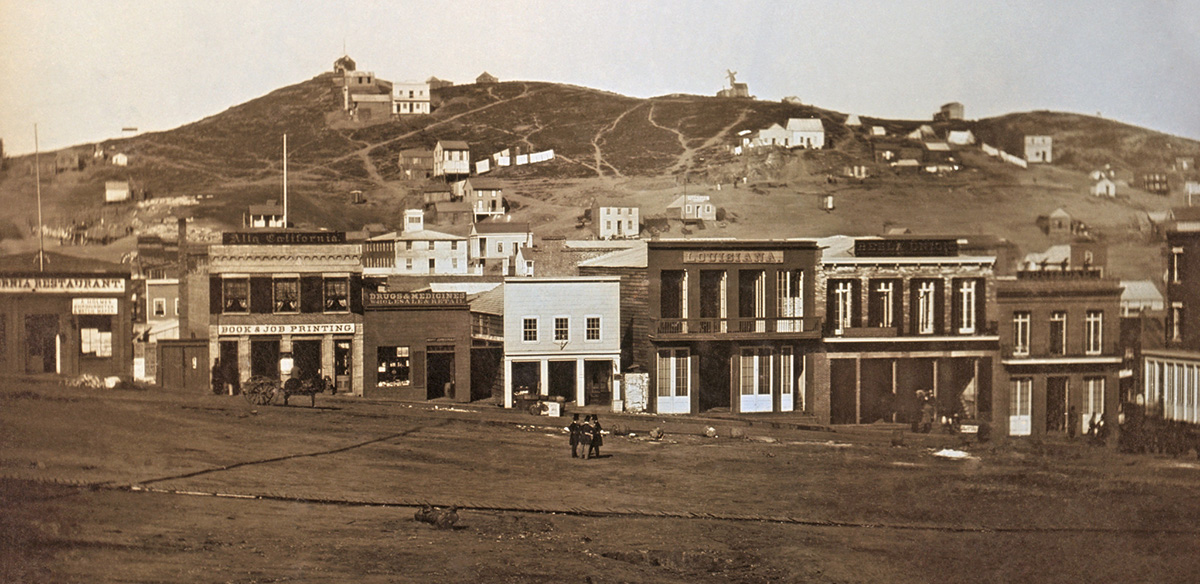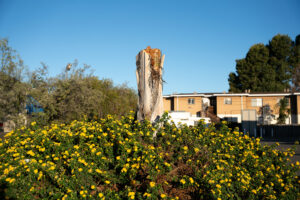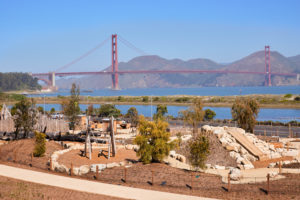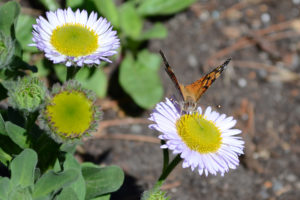
In the early 1990s, the United States Fish and Wildlife Service reviewed the status of a rare coastal sand dune plant called the San Francisco lessingia, which grows only in San Francisco and San Mateo Counties. The background the service collected was grim: 90 percent of the plant’s habitat had been destroyed since European settlement. Lessingia populations at Lake Merced, Lone Mountain, Ocean View Downs, and Mountain Lake had been bulldozed and were presumed extirpated. Once extensive habitat on San Bruno Mountain had been buried under the Colma dump, cemeteries, and a flower farm. By 1997, when the service wrapped up its review by listing the San Francisco lessingia as endangered, only six populations of the plant remained on Earth. New houses had just been approved within a few hundred yards of one and most of the remaining suitable habitat was overgrown with invasive iceplant.
The official listing announcement reads like a fragile plant’s indictment of humanity: “This taxon has been affected by and is endangered by competition from invasive alien plants, shading by alien and native plants, urban development, bulldozing, sand quarrying, fertilizer-contaminated runoff, habitat damage and trampling by pedestrians, bicycles, and off-road vehicles, and other human activities.”
The San Francisco lessingia is a familiar story of urbanization. Pretty much everything people do is bad for it. Cement and houses push nature ever farther into the margins, until there’s nowhere left to go. Extirpations and extinctions follow.
Yet, a team of scientists from the San Francisco Estuary Institute argue in a January 20 paper in the journal Bioscience, that loss does not have to be the only story of urbanization. Cities are bad for biodiversity, they say, but they also have major and still underappreciated potential. The paper is called “The Biological Deserts Fallacy: Cities in Their Landscapes Contribute More than We Think to Regional Biodiversity.”
“There’s been so much emphasis on the negative impacts on biodiversity,” says Erica Spotswood, the lead scientist at SFEI’s Urban Nature Lab and the first author on the paper. “That’s valid, but a singular focus on negatives has made it hard to see the potential benefits.”
Case in point, the paper says, is the San Francisco lessingia. Clearly the city has been bad for it. But after the listing decision, people have been good for the plant, too. Since the Presidio restored dune habitats around Lobos Creek in the early 2000s the number of individual San Francisco lessingia plants in the world has grown from maybe one thousand to more like a few million.
The San Francisco lessingia is one of what the paper identifies as “last-chance” species. Cities aren’t good for such species, but there’s also no other choice for them. The lessingia has no suitable habitat outside the gray boundaries of the modern city. But the thing about urban environments is how much human choice and preference matters there. If those choices could be directed toward conservation, it could be a fairly powerful counter to declining biodiversity worldwide.
“We have things that are in these cities that aren’t anywhere else and if we don’t protect them they will be lost,” says Presidio Trust Associate Director of Natural Resources Lew Stringer, who helped oversee the Presidio’s lessingia restoration. “That’s part of what the Presidio is all about.”
The stories of endangered urban plants like the San Francisco lessingia also overshadow the many other ways wild species exist with people. Some thrive in city environments — coyotes and peregrine falcons, for example, which the paper labels “urban beneficiaries.” Raptors like the falcons, or a number of hawk species, enjoy an abundance of prey plus greater protections in cities. Coyotes, one study shows, grow bolder and more curious in urban areas. Black widow spiders have greater genetic diversity in urban areas. No one loves the city more than a mallard duck.
Other species tend to choose cities as places to live, but don’t benefit. The paper labels these “ecological trap” species, and offers global examples including the Eurasian kestrel and Australian fruit bat. Understanding why they choose cities might reveal choices people can make to help ecological trap species better survive. And some species don’t choose cities but do better there nonetheless — like the buff-tailed bumblebee and gray catbird. The paper labels these “opportunity species.” Scientists studying Colorado black bears, another classic urban opportunist, have found that the bears will move back and forth between cities and open spaces depending on food availability, and that cities allow them to thrive even in times of scarcity.
“The race to me is: between now and 2050, say, we will have to house almost another 2 billion people in the world’s cities,” says Rob McDonald, the lead scientist for nature-based solutions at The Nature Conservancy. “We’re building the world’s future cities right now. We sort of get this moment in time to get those neighborhoods right, or we’ll be stuck with gray depressing cities.”

McDonald, who was not involved in the Bioscience paper but collaborates with Spotswood and SFEI, studies and has published several academic papers and policy reports on urban biodiversity. He wrote a 2015 book called Conservation for Cities. He says urban ecologists tend to broadly agree both on the damage cities can do to wildlife, and the potential, but that scientists can approach it through different philosophical lenses that can make it look like a glass-half-full or glass-half-empty debate. He says he admires the Bioscience paper for pointing out the positives; his role has mostly been to point out the negatives.
And there are negatives aplenty. In a 2019 literature review published in the journal Nature Sustainability, McDonald and several colleagues summarize the direct impact of cities on the environment. Many are fairly obvious: cities displace whatever was there before. Houses on top of meadows aren’t good for the meadows. But cities have indirect impacts, too, and those can be more difficult to tease out and are far less understood, the paper concludes. For example: a city needs water. That water might come from flooding and destroying a 1,200-acre valley 150 miles away. The indirect environmental impact of the city has to include the loss of the valley habitat, too.
Cities can also have indirect biodiversity benefits. A city resident tends to use less energy and water than a suburban or rural one. Though they’re bad for the land they’re built on, a city allows more people to live on less land overall, theoretically sparing greater acreage elsewhere.
Spotswood says part of the goal of the Bioscience paper is to get ecologists to think more about cities in a regional ecological context. She started thinking, she says, about the “species pool” of the Bay Area, and where the cities were situated within that pool. Big cities tend to be built in consistent types of places — lower elevations with water — which means there are certain types of habitat that at this point only exist within city outlines. The coastal dune habitat of San Francisco and Daly City is just one of several examples.
In San José, Spotswood says, rare alkali meadows made rich agricultural land and were incorporated early into the city’s urban footprint. To the extent alkali meadow species are still around, the city offers the only chance for preserving biodiversity unique to the entire region. Willow groves are an important stop for migratory songbirds in the Santa Clara Valley, but willows don’t grow much in the hills. They do colonize stormwater systems, though, so cities could choose to plant and protect willows to help support songbird diversity. In open spaces around the Bay Area, oak trees die from Sudden Oak Death, which often spreads from nearby California bay laurel trees. But in cities people haven’t traditionally planted those trees together, leaving oaks in cities standing as a refuge, released from the threats of the open spaces.
Cities also have the power of more people around to do maintenance, Spotswood says. California wildflowers struggle to compete with introduced annual grasses everywhere. But in a city there’s enough people around that everyone doing a little bit of weeding can keep a site clear. It’s hard to get thousands of people out into a wilderness area to plant native plants that benefit pollinators, and much easier to get people to care for those plants in their backyard gardens.
“You can only ignore urban landscapes for so long,” Spotswood says. “It’s worth pointing out they harbor species worth protecting. We need to be thinking about that, if they’re already serving a role, and how that role can be improved only if we embrace it.”
Cities can also effectively solve climate change problems with nature, McDonald adds. Low-income neighborhoods tend to be hotter, for example, and so climate warming will affect people in those neighborhoods most. By planting more trees in neighborhoods without them, a city can help its most vulnerable residents. By planting the right kind of trees, a city can help biodiversity. But such a win-win relies on government agencies communicating with each other. It’s an example of what some analysts call the “wrong pockets problem,” McDonald says, that in many cities it tends to be one department’s job to help residents dealing with heat effects, and another department’s job to boost biodiversity.
“Maybe it sounds like a truism but the first step is talking,” he says. “There’s still going to be a lot of ecologists like me doing ecosystem projects, biodiversity protection and planning projects. But I think the next frontier is having some visionary municipal leaders who want to capture all of these benefits, and then agencies working together to have that vision. It is hard work.”

Over the last 25 years, the Presidio, once a nearly fully developed Army base, has been home to many of San Francisco’s biggest ecological success stories. Plants and animals that haven’t been seen in the city for decades now can be found there, from dune flowers to bees and butterflies. The Presidio Trust’s Stringer and wildlife ecologist Jonathan Young say their work isn’t motivated by the idea of restoration of some particular past, but by the idea that people can design and build the environments they want. They’ve chosen, they say, an environment that blends some of the highlights of San Francisco’s past with its present and offers future climate resilience.
People will claim “you’re just building a glorified garden, why are you wasting money on this when you could be doing X, Y, and Z instead,” Young says. “But it’s a larger conversation that we’re talking about in the Presidio, in San Francisco, and obviously a global conversation. It seems like it’s the only path forward for the planet to get off the path we’re currently on.”
The idea of using our knowledge of ecology to create new human-reliant ecosystems runs counter to the western wilderness ethic of nature separated from people, and of parks and nature as healthy only when the human influence is fully removed. But think of the Presidio as a canvas, Stringer says — not a blank one, just a place to work as a nature-informed artist. What they’re doing, he says, is “painting with butterflies.”
“When we see life come back on the canvas of this landscape, that is an incredible feeling,” he says. “That I think spreads not just to us that gets to do it, but to everyone who gets to visit it.”
If the Presidio’s ecology team followed the logic of a separation between humans and nature and simply walked away to let nature take its course, Young says, “in 15 years it would just be ivy.”
“It comes back to what is it we as a society value?” he says. “And how do we get that, and how do we maintain that?”

One way to measure what a society values is to look at its urban forest. Urban parks and open spaces like the Presidio can make planting decisions at a landscape scale, sometimes with ecology top of mind, but street tree programs reflect much more the concerns and aesthetics of individuals and neighborhoods. Parks can show you what empowered ecologists think; street trees show you culture. Yet street trees in developed areas offer a much greater area to work with than the 20-30 percent of land parks occupy in many cities in the Bay Area.
San Francisco has a unique program that allows residents to work with a nonprofit, Friends of the Urban Forest, to plant street trees, which the city then maintains. Over the last 40 years, FUF has planted 60,000 trees on sidewalks throughout the city. These trees reflect individual choices, in all their messy complexity. Most urban trees in San Francisco in 2021 wouldn’t have been found within a thousand miles of the city before the 1800s. Occasionally, wandering the streets of San Francisco, you will see California-native live oaks or buckeyes, but far more often people have chosen Australian water gums, southeastern American liquidambars, New Zealand Christmas trees, Chinese ginkgos, Japanese cherries, London planes, and Mediterranean olives. The strawberry tree, probably the most common street tree in the city, is a relative of the native madrone that’s a purely ornamental creation from a cross between the Canary Islands strawberry tree and a hybrid of Irish and Greek strawberry trees.
FUF Urban Forestry Program Manager Mike Yarak says you can look at a map and see where there’s canopy cover, and where there are disparities, and where you might work to break up the concrete desert. The map would show you where the ecological opportunities lie. But the next step is not to show up with a tree and a shovel. Because you can’t just impose design on a city to prioritize ecology. A conversation about a tree, Yarak likes to say, is rarely just about the tree.
“We feel really strongly about giving people choice,” Yarak says. “We don’t want to just be the dictators of the urban forest, go put in what checks all these boxes on paper, this is what’s good for you. Especially working in areas where equity is an issue, because that’s more of the same. That’s what causes inequity in the first place.”
Everyone wants different things from trees and sidewalk. FUF wants trees that will survive in California’s future climate, contribute age class diversity, sequester carbon, not damage utility infrastructure, and of course make people happy. What makes people happy? Some people might want shade, and some people might want a tree that won’t grow into overhead power lines. Some people might want to avoid root damage to pipes. Some people don’t want to have to rake up fallen fruits or leaves. Some people want to park their cars on the sidewalk to avoid street sweeping tickets, and would be unhappy with any kind of street tree at all, but might take care of a sidewalk pollinator garden. Some people can’t put a tree in the front yard but would take one for their backyard. All of those people, though, want agency.
“People are more likely to be happy,” Yarak says, “if they get to choose their trees.”
What would help, Yarak says, is if every grant funded not just the planting itself but the preliminary work of engaging with community leaders and residents. With time and communication more people might come to value trees, Yarak says, and even certain types of trees. Outside its park boundaries a city is constrained by the botany of desire, but human desires change.
SFEI ecologist Spotswood says one first step in bringing about cultural change is communicating that the city is not a lost cause for biodiversity. An individual’s ecological choice in the city, multiplied by a few hundred people, becomes an important regional resource. Backyard milkweed and Dutchman’s pipevine make a difference for monarch and pipevine swallowtail butterflies. What else could city residents do?
“If species are responding to the urban landscape, then if you change the landscape they should respond,” Spotswood says. “We tend to think of what’s happening in the city as nothing. … But if you flip that around and say, ‘This is one of the most important places for this species,’ that provides motivation for stewardship and conservation.”




